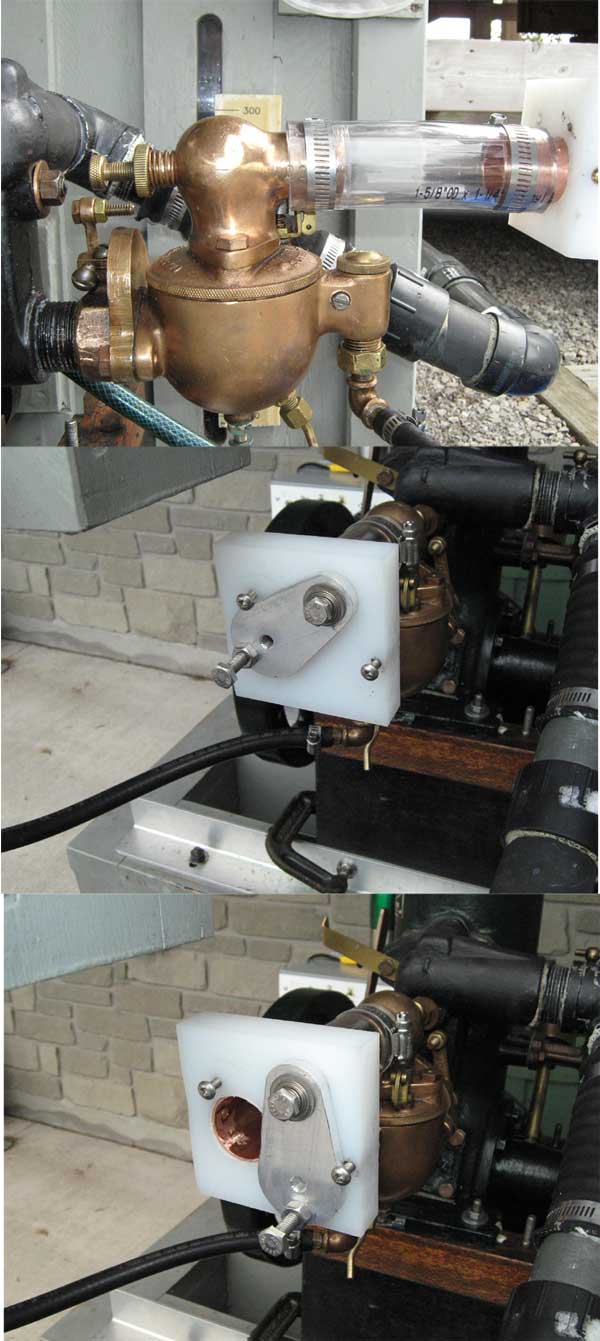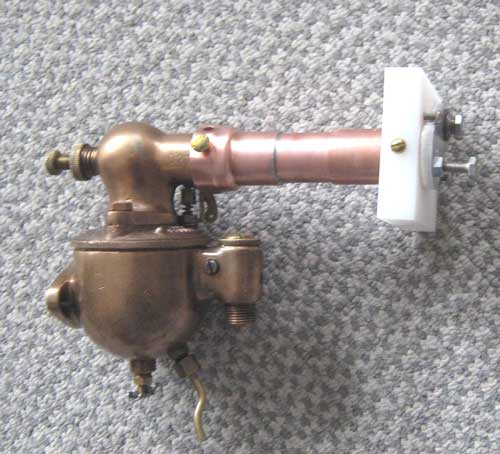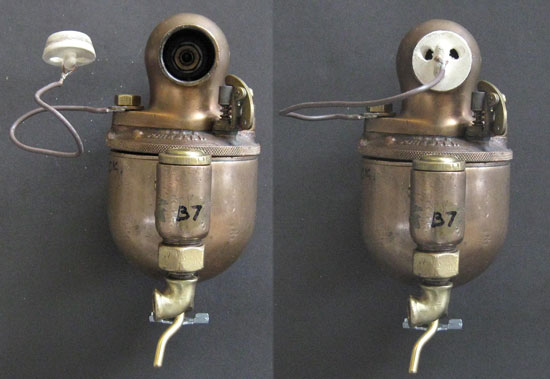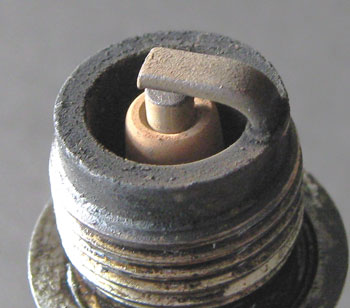| Author |
Message |
    
Barry Millar
Senior Member
Username: barry
Post Number: 118
Registered: 02-2006
| | Posted on Thursday, October 08, 2009 - 07:06 pm: | 




|
Attached image illustrates a mechanism that I use to adjust Schebler model D fuel/ air mixture. I find it convenient compared to adjusting the needle valve. This is useful during cold start and slow speed enrichment.
 |
    
John Archibald
Senior Member
Username: john_archibald
Post Number: 117
Registered: 08-2006

| | Posted on Thursday, October 08, 2009 - 08:05 pm: | 




|
And a black chemistry stopper with a hole in it doesn't woirk?
Archibald
. |
    
Ernie
Senior Member
Username: ernie
Post Number: 1066
Registered: 01-2002

| | Posted on Friday, October 09, 2009 - 07:50 am: | 




|
It won't pass Coast Guard Inspection here in the states |
    
Barry Millar
Senior Member
Username: barry
Post Number: 119
Registered: 02-2006
| | Posted on Friday, October 09, 2009 - 09:29 am: | 




|
Here is another version with all metal parts.
 |
    
Frank Petran
Senior Member
Username: frank_petran
Post Number: 68
Registered: 05-2009
| | Posted on Friday, October 09, 2009 - 11:29 am: | 




|
Again, as I am still somewhat a novice about these carburetors how does this device work. I know a little bit about the adjusting screw but do not understand it completely so how does this device replace the adjusting needle valve? |
    
Barry Millar
Senior Member
Username: barry
Post Number: 120
Registered: 02-2006
| | Posted on Saturday, October 10, 2009 - 09:50 am: | 




|
Frank,
I use a hand start two cycle engine to power my boat. Due to accessibility, adjustment of the needle is awkward so I initially set it for best operation then make no further adjustment during starting or slow speed operation.
I prime the engine at cold start and close the swing gate… refer to images. The engine starts first turn, then I gradually open the swing gate until stable operation occurs, about 5 – 10 seconds. During subsequent starts, I do not prime, rather use the swing gate depending on residual heat.
Closing the swing gate during very slow speed with ignition retarded results in slower speed than otherwise obtainable and more stable operation. |
    
Todd Vidgen
Senior Member
Username: todd_vidgen
Post Number: 141
Registered: 03-2008
| | Posted on Sunday, October 11, 2009 - 07:35 pm: | 




|
Seems like a lot of trouble to go to, because
if the carb is in good condition and set right
you need never touch the bottom mixture screw
or air valve screws.
In fact when Boyd and I rebuild them for people
and have set them for their engine,I tell them
"You may touch and adjust the Yellow parts,you
will notice however, THERE ARE NO YELLOW PARTS!" |
    
Ernie
Senior Member
Username: ernie
Post Number: 1069
Registered: 01-2002

| | Posted on Sunday, October 11, 2009 - 08:56 pm: | 




|
I never touch the adjustments on the Schebler in my boat. I took a lot of time when it was first in the water and found where it ran good. Fooled with it a bit at Mystic this year (Miro were you in the boat?) and put it back where it was. The key to consistant adjustments on a Schlebler are consistant fuel level and consistant gas/oil mix.
I almost never prime the engine just choke it with my hand once or twice and bounce start it. Once its running it runs good. |
    
Barry Millar
Senior Member
Username: barry
Post Number: 121
Registered: 02-2006
| | Posted on Tuesday, October 13, 2009 - 07:42 pm: | 




|
When discussing Schebler needle valve adjustment it’s a good idea to first determine needle angle in order to compare settings. I’ve measured many and concluded the factory angle was 40 degrees. I’ve run tests using other angles for example 25 degrees changes the setting by a factor of two, one half turn with a 40 degree needle produces same result as a 25degree needle opened one turn.
My boat engine is 3 1/4B x 3 1/2S single cylinder, two cycle engine. The propeller holds maximum RPM to 840. A 40 degree Schebler needle results in this RPM when opened to slightly more than ½ turn, about 190 degrees. When the engine is operating a max RPM, I close the air valve until RPM just starts to decrease, then open the valve about one turn. Then both adjustments are fixed and not adjusted during normal cruising same practice as Ernie and Todd.
During cold start when air temperature may be 10C ( 50F) I first position the piston about 90 degrees before TDC so that all ports are covered, set ignition at about 30 degrees retarded, open throttle plate, close the swing gate to cover air intake, prime then wait about 10 seconds until prime vaporizes, then pull flywheel over TDC. Engine fires …. then I gradually open swing gate as heat builds up to vapourize fuel and engine operation stabilizes, takes 5-10 seconds. Note the swing gate has a ¼” hole. Usually priming is not required during subsequent starts when the engine is still a bit warm, however the swing gate does provide a method of regulating the amount of choke as may be prudent.
Before adding the swing gate, I used a “sink stopper choke”. As soon as the engine fired I pulled the sink stopper choke and placed my thumb over the air intake to maintain engine operation during warm up. This works ok, however I found the swing gate works even better, image attached. I have never mastered the technique of holding my thumb over the air intake and pulling the flywheel at the same time.
During swing gate testing using my test bench, I discovered that I could reduce minimum RPM by an additional 150 RPM by almost closing the swing gate with ignition at max retard and throttle closed. This ultra low speed is an advantage when maneuvering in a crowded dockage.
I recall in a previous post, we discussed spark plug appearance as an indicator of correct carburetor adjustment and proper ignition. Thought I would reintroduce this subject by posting a new image of a spark plug.

 |
    
miro forest
Senior Member
Username: miro
Post Number: 397
Registered: 11-2001

| | Posted on Tuesday, October 13, 2009 - 09:28 pm: | 




|
Yes Ernie - I recall that we fooled with the setting a bit and then decided that - if it's running fine - leave it alone and enjoy the day.
Recently there have been so few nice summer days, that I prefer to get the engine on the DisPro ticking over and leave it at that.
My history of tweaking the carb usually results in wishing I'd left things as they were :-}
BTW - I have to revise my note about carb problems - 95% of them , not 80% of them are electrical.
For comparison I made up a JB lighting bolt maker box, to try out on the copper jacket engine - Usually I'd have to prime when cold.
Now -no prime needed and it runs like the wind - all the way up to 900 RPM - believe it or not.
miro |
    
Ernie
Senior Member
Username: ernie
Post Number: 1073
Registered: 01-2002

| | Posted on Wednesday, October 14, 2009 - 09:32 am: | 




|
Like you said 95% of carb problems are electrical.
I am working on an ignition system using a coil over plug ignition (no plug wire)from a new car. Very tiny no moisture concerns and at least 100K volts available. However I need either an Atwater Kent style of points or a solid state sensor as the coil needs just a few micro seconds of dwell (on) time. Both not easily done on my Gray. |
    
Barry Millar
Senior Member
Username: barry
Post Number: 122
Registered: 02-2006
| | Posted on Wednesday, October 14, 2009 - 07:13 pm: | 




|
One of the strengths of this discussion group is the opportunity to present opposite views without suggesting confrontation.
I hold a position opposite to the suggestion that 95% of carb problems are electrical. My view is that 95% of carb problems are not electrical, 5% are.
A simple two cycle engine only requires one electrical event, a high temperature occurrence at the spark plug to initiate the combustion process. Should this not occur then should the problem be electrical, this is easily identified and corrected as it relates only to the physical components, battery, coil, switches, wires, etc.
On the other hand the absence of combustion to initiate and continue engine operation is related to fuel vapour/air mixture and temperature. This process starts at the carburetor.
Carburetor set up and fuel issues are not transparent and easily identified as are electrical issues. |
    
John Archibald
Senior Member
Username: john_archibald
Post Number: 119
Registered: 08-2006

| | Posted on Wednesday, October 14, 2009 - 07:50 pm: | 




|
Barry,
Do you need a shovel?
Archibald
. |
    
Todd Vidgen
Senior Member
Username: todd_vidgen
Post Number: 142
Registered: 03-2008
| | Posted on Thursday, October 15, 2009 - 04:43 pm: | 




|
Dig,dig,dig,ahhh 6ft at last |
    
Todd Vidgen
Senior Member
Username: todd_vidgen
Post Number: 143
Registered: 03-2008
| | Posted on Thursday, October 15, 2009 - 04:49 pm: | 




|
Oh John,just thought to remind all about this years
regatta over here at Davistown,central coast,
New South Wales,Australia,is on again November 1
We have 55 entries so far,and considering the way
peoples pockets have been hurt in the last year,I
think thats not to bad. (seeing your post reminded me) Cheers all |
    
Barry Millar
Senior Member
Username: barry
Post Number: 123
Registered: 02-2006
| | Posted on Thursday, October 15, 2009 - 07:00 pm: | 




|
John, Todd,
I don't understand your posts so am unable to reply.
Please help.
Barry |
    
William Vlies
New member
Username: billv
Post Number: 3
Registered: 06-2007
| | Posted on Tuesday, October 20, 2009 - 02:41 am: | 




|
Hi New to this. Re coil over plug ignition. the electronics mags and stores had circuits and kits for a dwell extender. Reduces the points open time resulting in a far fatter spark. I have built and tested some. They should still be around
BillV |


